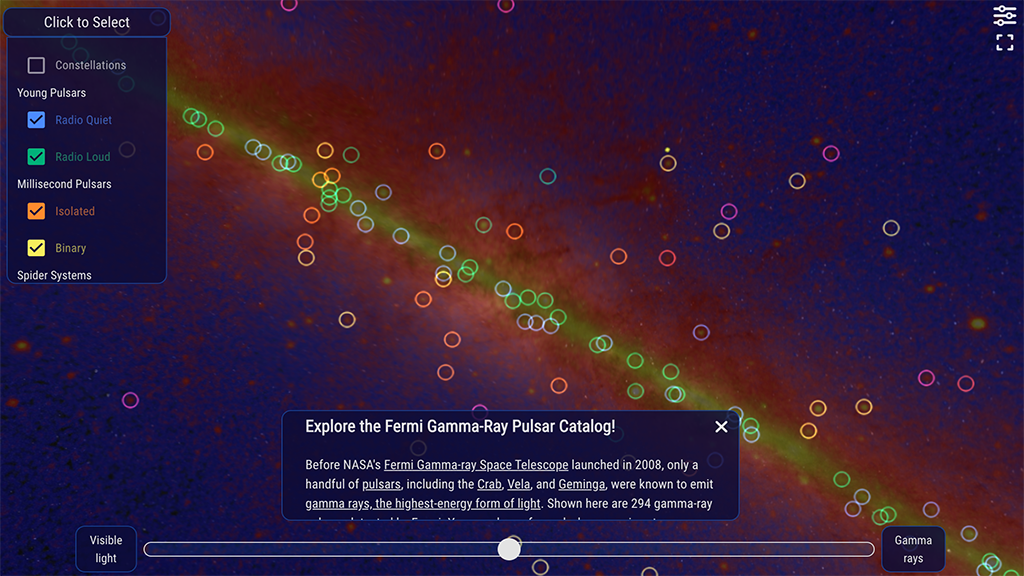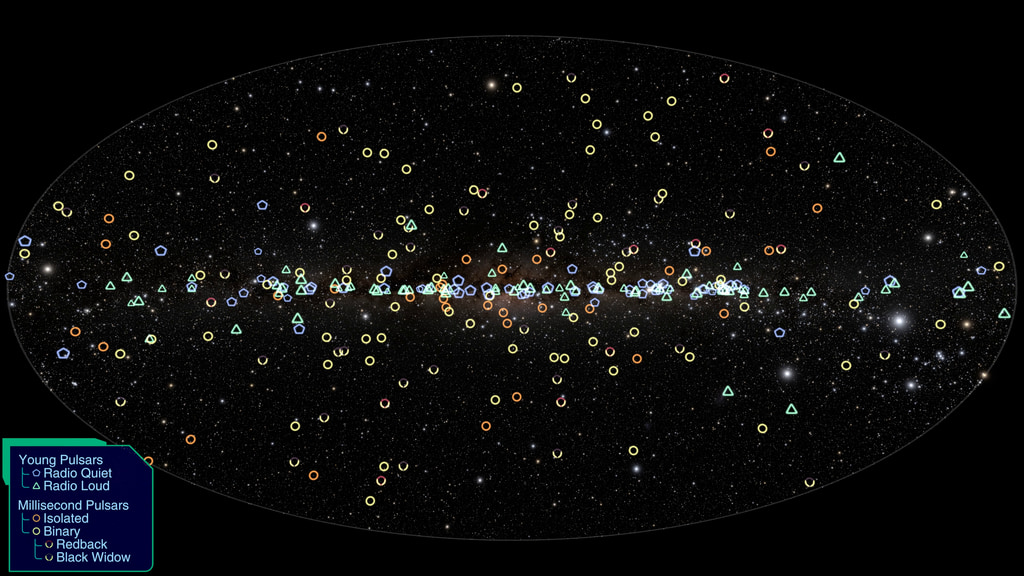NASA’s Fermi Mission Finds 300 Gamma-Ray Pulsars
This visualization shows 294 gamma-ray pulsars, first plotted on an image of the entire starry sky as seen from Earth and then transitioning to a view from above our galaxy. The symbols show different types of pulsars. Young pulsars blink in real time except for the Crab, which pulses slower because its rate is only slightly lower than the video frame rate. Millisecond pulsars remain steady, pulsing too quickly to see. The Crab, Vela, and Geminga were among the 11 gamma-ray pulsars known before Fermi launched. Other notable objects are also highlighted. Distances are shown in light-years (abbreviated ly).
Credit: NASA’s Goddard Space Flight Center
Music: "Fascination" from Universal Production Music
Watch this video on the NASA.gov Video YouTube channel.
Complete transcript available.
A new catalog produced by a French-led international team of astronomers shows that NASA’s Fermi Gamma-ray Space Telescope has discovered 294 gamma-ray-emitting pulsars, while another 34 suspects await confirmation. This is 27 times the number known before the mission launched in 2008.
Pulsars touch on a wide range of astrophysics research, from cosmic rays and stellar evolution to the search for gravitational waves and dark matter. They are a type of neutron star, the city-sized leftover of a massive sun that has exploded as a supernova. Neutron stars, containing more mass than our Sun in a ball
less than 17 miles wide, represent the densest matter astronomers can study directly. They possess strong magnetic fields, produce streams of energetic particles, and spin quickly 716 times a second for the fastest known. Pulsars, in addition, emit narrow beams of energy that swing lighthouse-like through space as the objects rotate. When one of these beams sweeps past Earth, astronomers detect a pulse of emission.
The new catalog represents the work of 170 scientists across the globe. A dozen radio telescopes carry out regular monitoring of thousands of pulsars, and radio astronomers search for new pulsars within gamma-ray sources discovered by Fermi. Other researchers have teased out gamma-ray pulsars that have no radio counterparts through millions of hours of computer calculation, a process called a blind search.
Fermi's neutron star discoveries even extend beyond our galaxy. The mission discovered the first gamma-ray pulsar in another galaxy, the neighboring Large Magellanic Cloud, in 2015. And in 2021, astronomers announced the discovery of a giant gamma-ray flare from a magnetar — a different type of neutron star — located in the Sculptor galaxy, about 11.4 million light-years away.
Same as above with labeling in French.
Credit: NASA’s Goddard Space Flight Center
Music: "Fascination" from Universal Production Music
Complete transcript available.
Same as above with labeling in German.
Credit: NASA’s Goddard Space Flight Center
Music: "Fascination" from Universal Production Music
Complete transcript available.
This artist's rendering illustrates a possible model for the transitional pulsar J1023. When astronomers can detect pulses in radio (green), the pulsar's energetic outflow holds back its companion's gas stream. Sometimes the stream surges, creating a bright disk around the pulsar that can persist for years. The disk shines brightly in X-rays, and gas reaching the neutron star produces jets that emit gamma rays (magenta), obscuring the pulses until the disk eventually dissipates.
Credit: NASA's Goddard Space Flight Center

This movie shows the Vela pulsar in gamma rays detected by the Large Area Telescope aboard NASA's Fermi observatory. A single pulsar cycle is repeated. Bluer colors indicate gamma rays with higher energies.
Credit: NASA/DOE/Fermi LAT Collaboration

This artist's rendering shows narrow beams of energy emerging from hot spots on the surface of a neutron star. When one of these beams sweeps past Earth, astronomers detect a pulse of light.
Credit: NASA's Goddard Space Flight Center Conceptual Image Lab

Artist's concept of a spinning pulsar and its lighthouse-like beams of radiation.
Credit: NASA's Goddard Space Flight Center
Credits
Please give credit for this item to:
NASA's Goddard Space Flight Center. However, individual items should be credited as indicated above.
-
Science writer
- Francis Reddy (University of Maryland College Park)
-
Producer
- Scott Wiessinger (KBR Wyle Services, LLC)
-
Editor
- Scott Wiessinger (KBR Wyle Services, LLC)
-
Visualizers
- Mark SubbaRao (NASA/GSFC)
- A. J. Christensen (AVL NCSA/University of Illinois)
-
Scientists
- Elizabeth Hays (NASA/GSFC)
- David A. Smith (Laboratoire d'Astrophysique de Bordeaux)
Release date
This page was originally published on Tuesday, November 28, 2023.
This page was last updated on Thursday, November 2, 2023 at 2:45 PM EDT.








